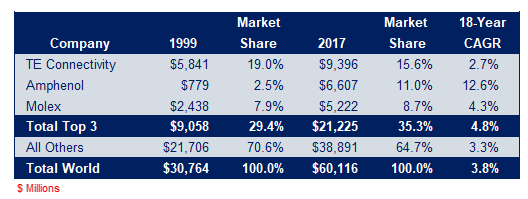Mergers and Acquisitions in the Connector Industry
The electronics industry must respond to constant shifts in technology, product development, and market growth. Some companies nurture that capability in-house, while others gain expertise through strategic acquisitions. Here’s a brief history of that strategy as enacted by and upon connector companies.

Since 1985, Bishop & Associates has recorded 589 mergers and acquisitions in the connector industry. Between 1985 and 1999 there were 126 acquisitions. The pace of closed deals has accelerated significantly. Since 2000, there were 463 transitions. For the purposes of this article, we drew a line at October 1, 2018. However, in the first two weeks of October, several acquisitions have occurred and more are possible as the year winds down. (We’ll include those acquisitions in future tallies.)
The three largest connector companies have been very active in acquiring competitors. Between 1999 and 2017, Amphenol acquired 49 companies, and has already acquired three companies in 2018. In that same span, Molex acquired 27 and TE Connectivity 25.
Special note: Amphenol could probably give pointers to Warren Buffet. While acquiring 52 companies, Amphenol has achieved “industry best” financial performance. The company’s net income and return on equity are consistently in the double digits and are the highest in the industry.
The following table identifies the impact acquisitions have had on the connector industry.
Big Three Performance
1999 to 2017
Important Highlights
The big three combined owned 29.4% of the connector market in 1999. Big three market share increased to 35.3% by 2017.
The big three achieved an 18-year compound annual growth rate (CAGR) of 4.8% from 1999 to 2017. The balance of the connector industry achieved a 3.3% CAGR.
Amphenol’s aggressive acquisition program (49 deals between 1999 and 2017) resulted in an 18-year CAGR of 12.6%. Their market share increased from 2.5% in 1997 to 11.0% in 2017.
There is no doubt that acquisitions have had a significant impact on the connector industry. For example, many important connector companies have been absorbed into larger entities and have disappeared. Among these are Augat, FCI, Robinson Nugent, Cardell, and M/A-Com. Others, including Teradyne, Litton Industries, Thomas & Betts, TRW, and Labinal, still exist but have sold off their connector businesses.
For more information on mergers and acquisitions among the connector, cable, and cable assembly markets, see Bishop & Associates newest research report, History of M & A in the Connector Industry (Shrinking Footprints: Connector Industry Consolidation 1954-2018).
- Is the Gold Rush Over for China Connector Sales? - October 17, 2023
- The Top Five European Connector Suppliers for Product Quality and Price Competitiveness - October 10, 2023
- 2023 Top Five European Connector Suppliers - September 26, 2023







